Key takeaways:
- Flexible learning spaces enhance creativity and collaboration by allowing students to interact and express themselves in a comfortable environment.
- These spaces promote inclusivity and cross-disciplinary learning, leading to diverse ideas and increased student engagement.
- Effective implementation requires clear vision, continuous assessment, and professional development for educators to adapt teaching strategies.
- Challenges include varying student responses to flexibility, potential distractions, and the need for careful planning of layouts for effective teaching.
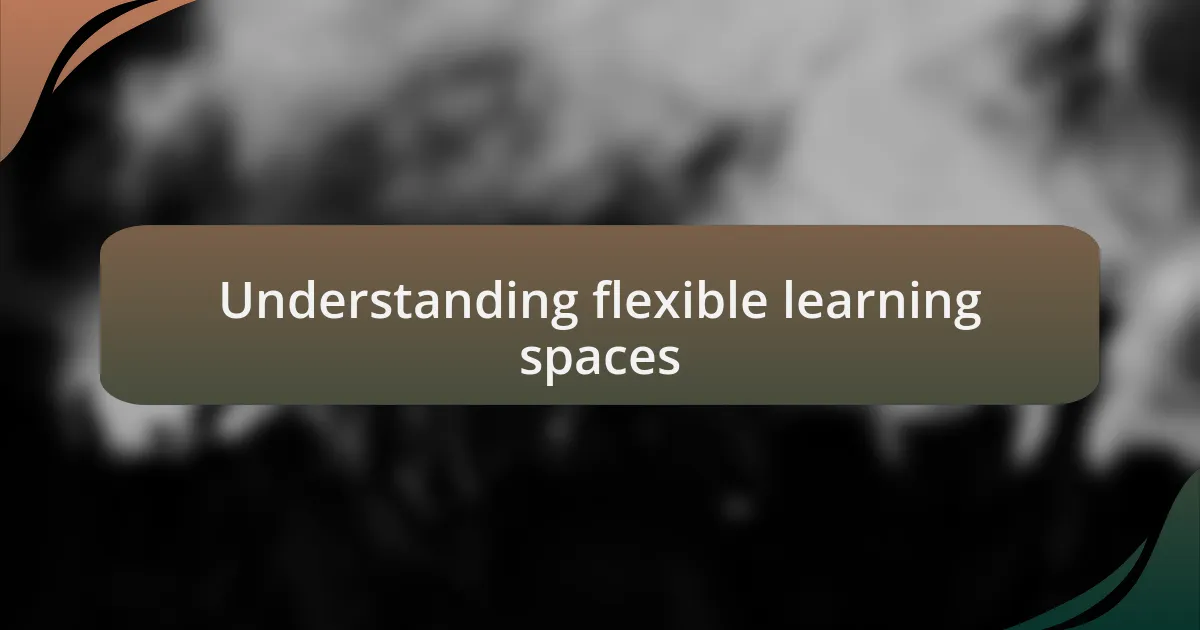
Understanding flexible learning spaces
Flexible learning spaces are designed to adapt to various teaching methods and learning styles, fostering creativity and collaboration. I remember walking into a classroom where the traditional rows of desks were replaced with bean bags and tables that could be rearranged. It was incredible to see how this setup encouraged students to interact and experiment with their music projects, turning the classroom into a dynamic hub of creativity.
These spaces often incorporate technology to enhance learning, such as interactive whiteboards and mobile devices. I once participated in a group project where we used tablets to compose music collaboratively, sharing ideas in real time. Have you ever thought about how technology can elevate a simple music lesson into an interactive experience? It was eye-opening for me, as I realized that flexible environments can truly inspire both students and educators to think outside the box.
The emotional impact of flexible learning spaces shouldn’t be underestimated. When students feel comfortable in their environment, they are more willing to express themselves. I once witnessed a shy student thrive in a cozy corner of the room, sharing an original composition. It’s moments like these that highlight just how vital a well-designed space can be to the learning process. What changes have you noticed in your own environment when it offers flexibility?
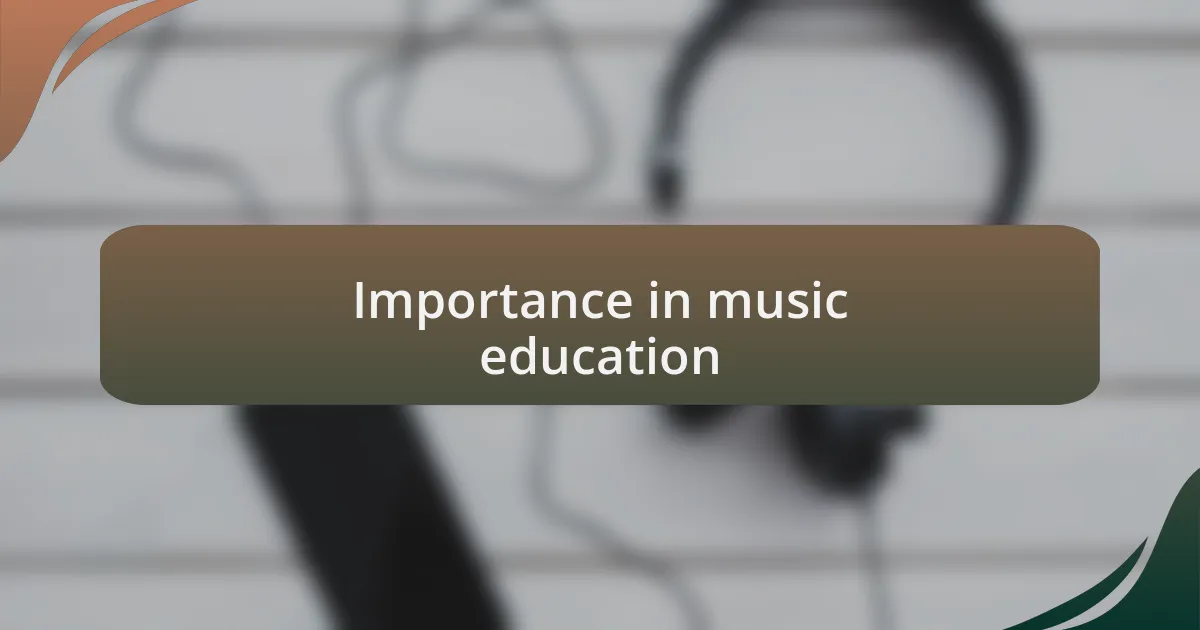
Importance in music education
The importance of flexible learning spaces in music education cannot be overstated. During my time teaching, I noticed that students thrived when they could choose their own working environment. For instance, I once allowed a group of students to select their spots for a collaborative composition project. They gravitated toward different corners of the room, and their unique spaces led to a diverse range of musical ideas. Have you seen how a little freedom can spark creativity?
Additionally, these adaptable environments promote inclusivity, inviting every student to participate actively. I remember working with students who were typically reserved; they began to shine in spaces that encouraged group discussions and improvisation. One day, a usually quiet student took the lead during a jam session, showcasing their talent in a supportive atmosphere. It’s moments like these that remind me how essential it is to create a comfortable space for self-expression. What about your experience—have you seen students open up in a more flexible setting?
Moreover, flexible spaces facilitate cross-disciplinary learning which is crucial in music education. In one class, we integrated visual arts by using design elements to enhance our musical pieces. I was amazed at how the visuals influenced the mood and expression of the music created. This blending of subjects not only enriched our lessons but also deepened students’ understanding of the interconnectedness of the arts. Can you think of ways that different disciplines could enhance your own music education experience?
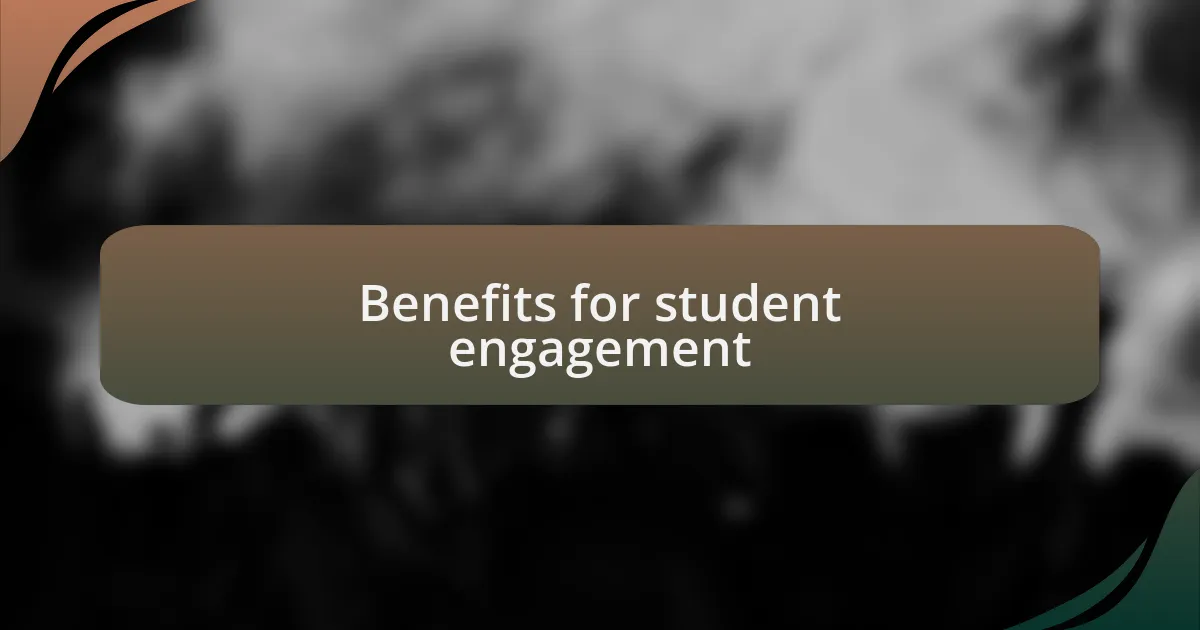
Benefits for student engagement
The impact of flexible learning spaces on student engagement is profound. I recall a project where students could choose their instruments and seating arrangements for a group performance. This freedom ignited their enthusiasm, and I was astounded to witness students who usually hesitated in front of an audience confidently share their musical interpretations. Have you ever seen quiet students come alive simply because they felt empowered to express themselves in their own way?
Creating varied learning spots not only caters to diverse learning styles but also fosters collaboration. I remember a time when students organized themselves into small circles for peer feedback on their compositions. The informal nature of these circles led to lively discussions and spontaneous brainstorming, which I found was far more effective than traditional feedback sessions. Isn’t it amazing how a simple change in setting can lead to richer interactions among students?
Moreover, flexible spaces allow for more meaningful connections, both socially and academically. I witnessed a group of students bonding over a shared love of music while refining their skills in a less structured environment. In those moments, the barriers between them dissolved, transforming their music sessions into a community of support and creativity. Have you noticed how such environments can foster lasting friendships and collective exploration?
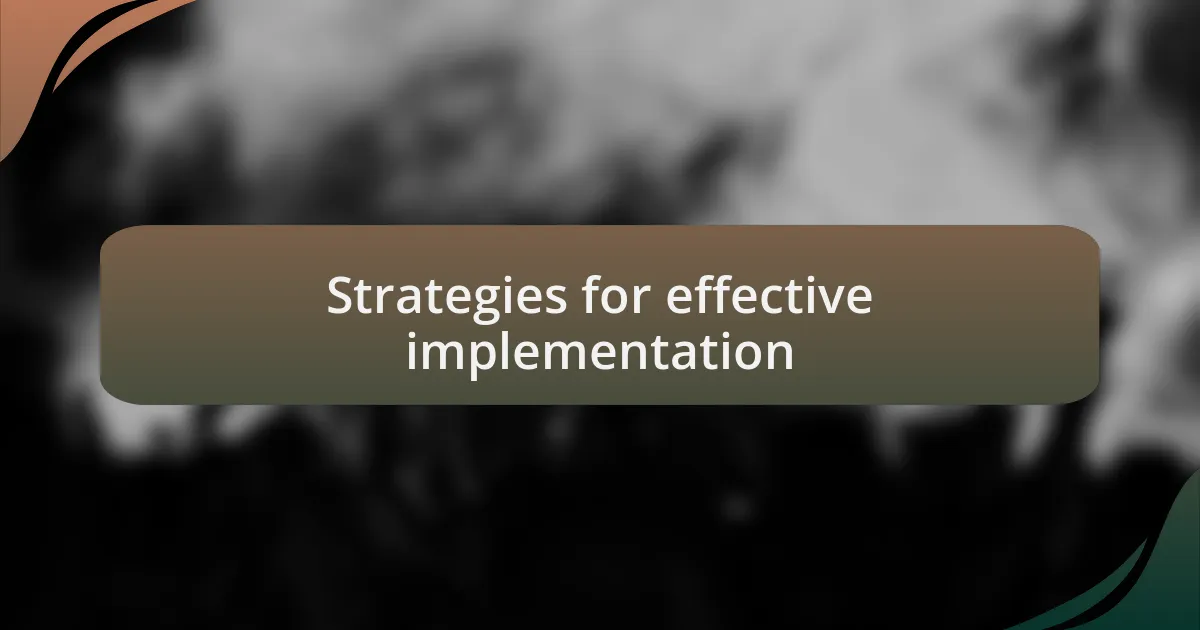
Strategies for effective implementation
To effectively implement flexible learning spaces, it’s crucial to start with a clear vision of what you want to achieve. During one of my lectures, I organized a brainstorming session where students collectively envisioned their ideal learning environment. The excitement in the room was palpable as they articulated their needs and desires. Have you ever felt that spark when a group shares a common goal? It’s a powerful reminder that involving students in the planning process can enhance their commitment and ownership of the learning experience.
Another key strategy involves continuous assessment and adaptation. I often check in with my students after implementing changes, asking them how the new layout is affecting their learning. One memorable moment occurred when students shared that rearranged furniture led to more spontaneous group discussions, creating a buzz of creativity. Have you thought about how feedback can shape a learning environment? This iterative process not only refines the space but also empowers students to express their preferences, making them active participants in their education.
Moreover, providing professional development opportunities for educators is essential. When I attended a workshop on flexible learning strategies, the practical tips and engaging discussions sparked fresh ideas I could bring back to my classroom. Such experiences highlight the importance of equipping educators with the tools to thrive in these dynamic spaces. Isn’t it fascinating how investing in teacher training can ripple through an entire classroom, benefiting both teachers and students?
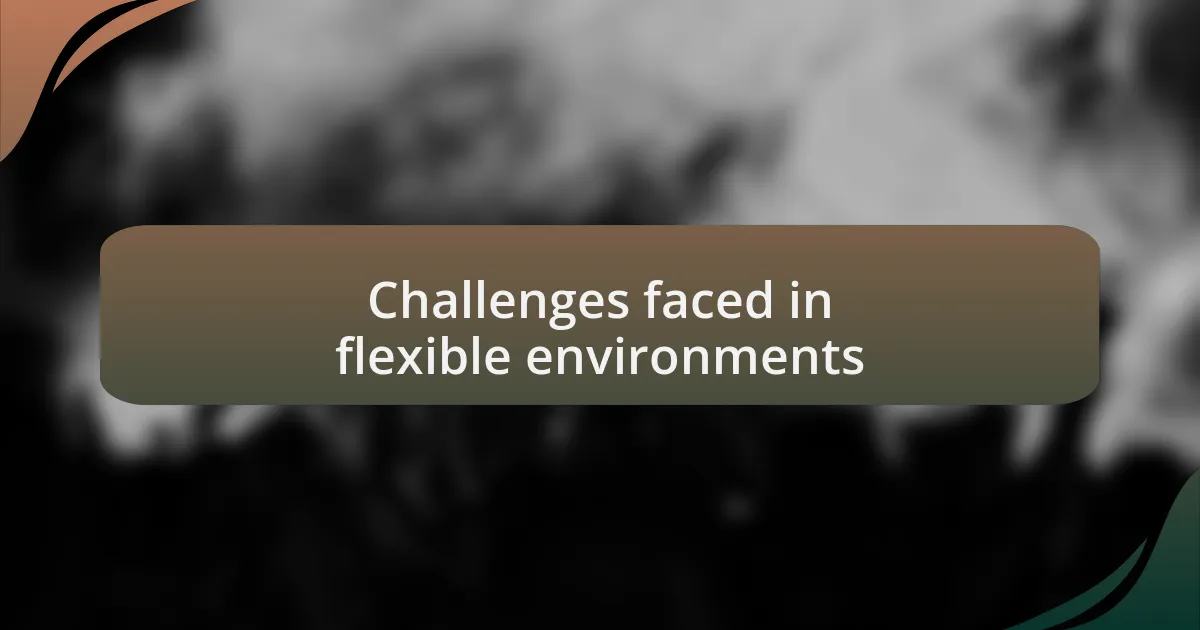
Challenges faced in flexible environments
Implementing flexible learning spaces can come with its set of challenges. One issue I encountered was the disparity in how students responded to the new arrangements. While some thrived in a less structured environment, others felt lost without clear boundaries and guidance. Have you ever noticed how varied student needs can be? It’s a stark reminder that one size doesn’t fit all, and it’s essential to recognize these differences to foster an inclusive atmosphere.
Another challenge is the potential for distractions in a flexible setting. I vividly remember a class where the open layout invited constant movement and noise, making it hard to keep everyone focused. One of my students, who usually excelled, struggled to concentrate with peers chatting nearby. This experience taught me that while flexibility encourages collaboration, it can also lead to chaotic moments that require careful management. How do you balance freedom and structure in a learning environment?
Finally, the layout itself can sometimes hinder effective teaching. I once arranged a space for group work, only to find that the acoustics made it difficult for me to support each group adequately. It was a frustrating realization that even the best intentions could fall short without proper planning. I began to think about how critical it is to test new designs before fully committing to them. Have you ever faced similar setbacks when trying something new? It’s part of the learning curve, but one that can ultimately lead to better solutions.
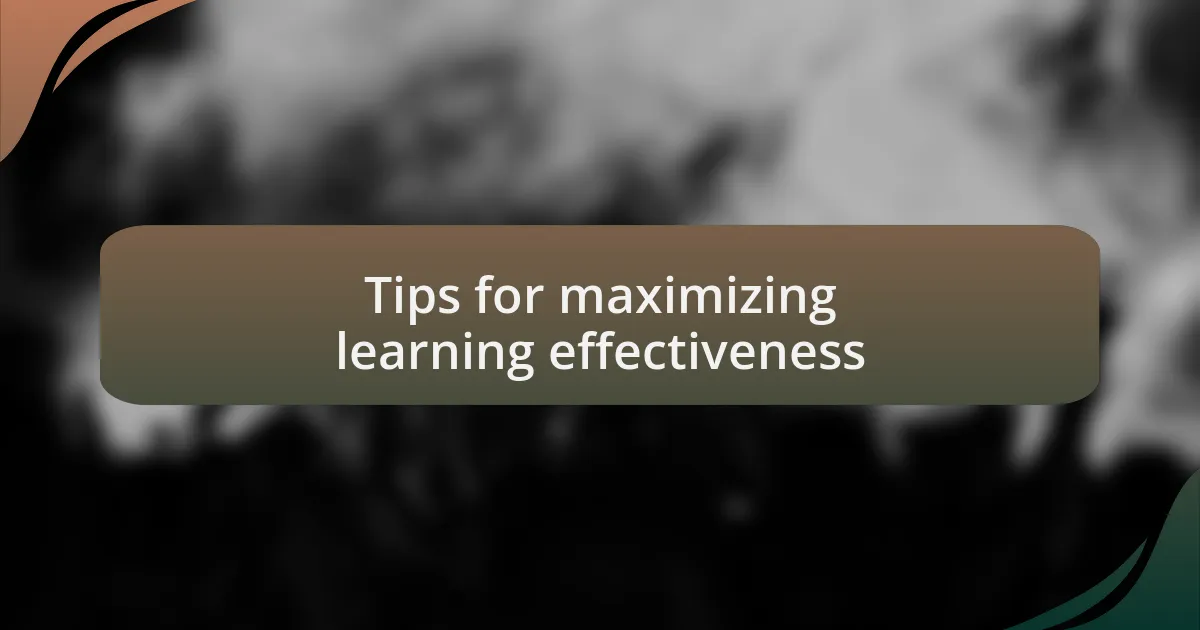
Tips for maximizing learning effectiveness
One strategy I find essential for maximizing learning effectiveness in flexible spaces is establishing clear guidelines. I remember a time when my students had the freedom to choose their own work areas, but without set expectations, it was like a free-for-all. By introducing specific roles and responsibilities during group activities, I noticed a significant increase in productivity and focus. How often do we assume students will self-regulate? Clearly defined boundaries can create an environment where everyone feels empowered to contribute.
Another tip is to incorporate varied teaching methods to cater to different learning styles. In one memorable project, I combined traditional instruction with hands-on, collaborative activities, and the difference was remarkable. Students who usually struggled with theory thrived when they could engage with the material creatively. Isn’t it interesting how a little variety can inspire such enthusiasm? I would encourage you to mix up your approach—it keeps students engaged and can unveil hidden talents.
Lastly, continuous feedback is crucial in these settings. I initiated regular check-ins with my students to discuss what was working and what wasn’t. This transparency fostered a sense of community and allowed them to voice their needs. Have you ever had a moment where feedback led to unexpected insights? It’s vital to adapt and evolve based on students’ experiences, ensuring that the flexible learning space truly supports their educational journey.